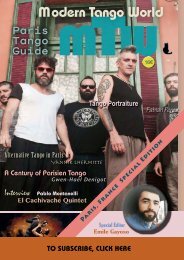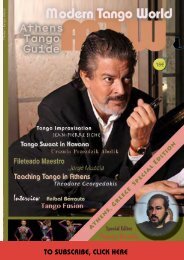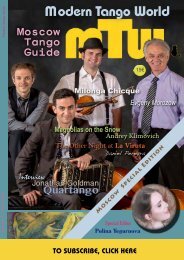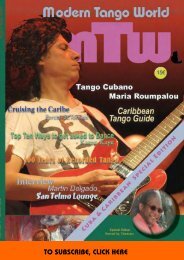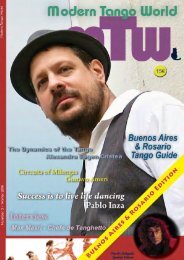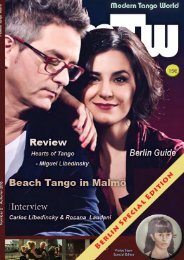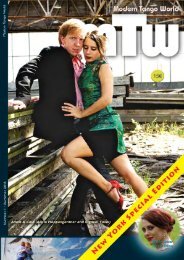Modern Tango World #4 (Bucharest, Romania)
Romania Special Features Romania’s Modern Tango Scene Dragos Samoil 3 An Act of Beauty Laura Iaru 6 Guitar Man Alexandru Eugen Cristea 12 Guide to Tango in Romania 16 The Ladies of Guardia Viejo Renato Mantioni 20 Interview with Miguel di Genova Marco Buso 24 Tango Addiction Kiran Bajaj Sawhney 28 New Tango Music Arndt Büssing 32 The Obamas Tango in Buenos Aires 38 DJ/VJ-ing - Victroleras, Tandas & Cortinas Igor Shpigelman 40 Tango Moves - Abrazos Raymond Lauzzana 44 Letters to the Editor 47
Romania Special Features
Romania’s Modern Tango Scene Dragos Samoil 3
An Act of Beauty Laura Iaru 6
Guitar Man Alexandru Eugen Cristea 12
Guide to Tango in Romania 16
The Ladies of Guardia Viejo Renato Mantioni 20
Interview with Miguel di Genova Marco Buso 24
Tango Addiction Kiran Bajaj Sawhney 28
New Tango Music Arndt Büssing 32
The Obamas Tango in Buenos Aires 38
DJ/VJ-ing - Victroleras, Tandas & Cortinas Igor Shpigelman 40
Tango Moves - Abrazos Raymond Lauzzana 44
Letters to the Editor 47
Create successful ePaper yourself
Turn your PDF publications into a flip-book with our unique Google optimized e-Paper software.
Alfredo De Angelis playing, 15 minutes sets at 11:00 on Radio El Mundo. (Scan by M. Krugman).<br />
Electric recording was introduced to Buenos Aires<br />
in 1926, and so, pushed to new artistic standards<br />
by Julio De Caro, accepted into the higher society<br />
and propelled by the technology, new tango sextetos<br />
started appearing almost daily. But their life was<br />
quite short. Less than three years later, the crisis of<br />
1929, together with the introduction of sound motion<br />
pictures put an end to their blissful existence<br />
With the swing of a pendulum from a lot in 1926 to<br />
a few in 1929, the increased demand for tango music<br />
could easily become higher than the supply, and<br />
the job of victroleras, which had been technically<br />
feasible since 1926, became a demanded occupation<br />
in 1929. The tango La Victrolera was recorded<br />
only a year later. We can firmly place the emergence<br />
and the proliferation of victroleras in Argentina into<br />
a single year period between 1929 and 1930, not<br />
only in Buenos Aires, but in other cities as well, as<br />
the angry letter, written by Those darnn Victrolas<br />
in a local Santa Fe newspaper attests<br />
However,, Matt Mateo pointed out in an online discussion,<br />
we cannot yet say for sure, whether these victroleras<br />
were indeed playing music for dancers in the<br />
clubs, akin modern musicalizadors or DJs, or served<br />
more like long-legged local attractionsf or the patrons<br />
of cafes, as the heroine a Fellini-like story La Vitrolera.<br />
When the custom playing tandas separated by<br />
cortinas appear?<br />
Firstly we should mention a well-thought answer<br />
to this question that appeared in <strong>Tango</strong>-L mail list.<br />
However, the brothel origin of tango, and the very<br />
existence of tango academias is more of a legend<br />
than a historical fact, and also, this answer was met<br />
with lots of criticism on the ground that live orquestas<br />
do not play music in tandas. Many modern tango<br />
orquestas do not play any danceable music. Those<br />
few that do, pften use tandas format, in one or another<br />
form. But what about the orquestas of the<br />
Golden Age? And what about the early DJs?<br />
In the Golden Age a contract on the radio was a prestigious<br />
and a lucrative source of income for any orquesta<br />
tipica. The standard radio format was to have<br />
an orquesta tipica play a live quarter-hour set, change<br />
the type of programming for the next quarter-hour,<br />
and then play another quarter-hour set, and so on. Of<br />
course, any orquesta worthy of its name, would not<br />
just randomly chose pieces from its repertoire, but<br />
rather build this fifteen minutes set into a certain story,<br />
with a beginning, culmination and conclusion. At least<br />
for the radio performances, an orquesta tipica would<br />
use a format, both by its length and its design similar,<br />
although not identical to a modern tanda.<br />
— 43 —




